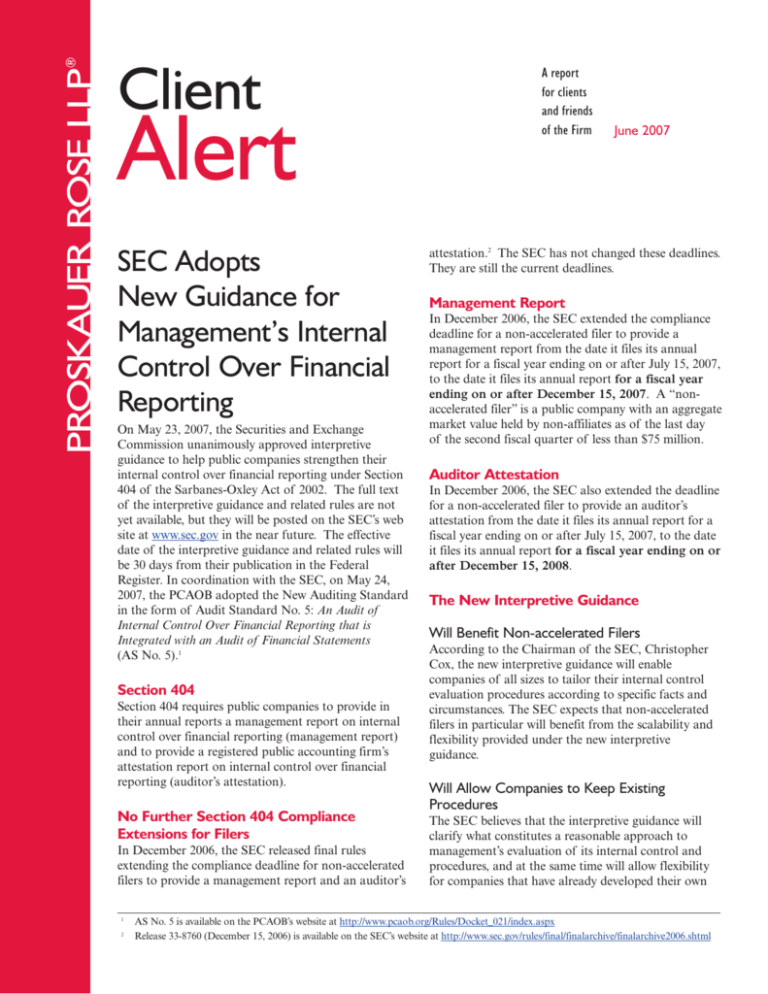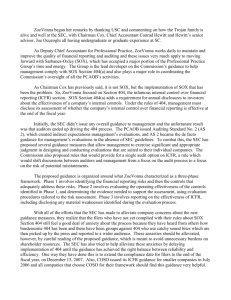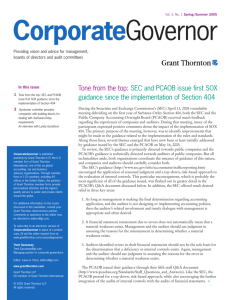
®
PROSKAUER ROSE LLP
Client
Alert
SEC Adopts
New Guidance for
Management’s Internal
Control Over Financial
Reporting
On May 23, 2007, the Securities and Exchange
Commission unanimously approved interpretive
guidance to help public companies strengthen their
internal control over financial reporting under Section
404 of the Sarbanes-Oxley Act of 2002. The full text
of the interpretive guidance and related rules are not
yet available, but they will be posted on the SEC’s web
site at www.sec.gov in the near future. The effective
date of the interpretive guidance and related rules will
be 30 days from their publication in the Federal
Register. In coordination with the SEC, on May 24,
2007, the PCAOB adopted the New Auditing Standard
in the form of Audit Standard No. 5: An Audit of
Internal Control Over Financial Reporting that is
Integrated with an Audit of Financial Statements
(AS No. 5).1
Section 404
Section 404 requires public companies to provide in
their annual reports a management report on internal
control over financial reporting (management report)
and to provide a registered public accounting firm’s
attestation report on internal control over financial
reporting (auditor’s attestation).
No Further Section 404 Compliance
Extensions for Filers
In December 2006, the SEC released final rules
extending the compliance deadline for non-accelerated
filers to provide a management report and an auditor’s
1
2
A report
for clients
and friends
of the Firm
June 2007
attestation.2 The SEC has not changed these deadlines.
They are still the current deadlines.
Management Report
In December 2006, the SEC extended the compliance
deadline for a non-accelerated filer to provide a
management report from the date it files its annual
report for a fiscal year ending on or after July 15, 2007,
to the date it files its annual report for a fiscal year
ending on or after December 15, 2007. A “nonaccelerated filer” is a public company with an aggregate
market value held by non-affiliates as of the last day
of the second fiscal quarter of less than $75 million.
Auditor Attestation
In December 2006, the SEC also extended the deadline
for a non-accelerated filer to provide an auditor’s
attestation from the date it files its annual report for a
fiscal year ending on or after July 15, 2007, to the date
it files its annual report for a fiscal year ending on or
after December 15, 2008.
The New Interpretive Guidance
Will Benefit Non-accelerated Filers
According to the Chairman of the SEC, Christopher
Cox, the new interpretive guidance will enable
companies of all sizes to tailor their internal control
evaluation procedures according to specific facts and
circumstances. The SEC expects that non-accelerated
filers in particular will benefit from the scalability and
flexibility provided under the new interpretive
guidance.
Will Allow Companies to Keep Existing
Procedures
The SEC believes that the interpretive guidance will
clarify what constitutes a reasonable approach to
management’s evaluation of its internal control and
procedures, and at the same time will allow flexibility
for companies that have already developed their own
AS No. 5 is available on the PCAOB’s website at http://www.pcaob.org/Rules/Docket_021/index.aspx
Release 33-8760 (December 15, 2006) is available on the SEC’s website at http://www.sec.gov/rules/final/finalarchive/finalarchive2006.shtml
assessment procedures and tools. Companies will be able to
continue using their existing assessment procedures if they
choose, as long as those procedures comply with Section 404.
emphasizing the importance of auditing higher risk
areas, such as the financial statement close process
and controls designed to prevent fraud by
management; and
suggesting alternatives for addressing lower risk
areas, like calibrating the nature, timing and extent of
testing based on risk, and using knowledge from
prior audits and from work performed by company
personnel.
New Rule Amendments
In connection with the new interpretive guidance, the SEC
also approved rule amendments providing:
a safe harbor for a company that performs an evaluation
of internal control in accordance with the new
interpretive guidance, which will satisfy the annual
evaluation required by Exchange Act Rules 13a-15 and
15d-15;
the definition of the term “material weakness” is “a
deficiency, or combination of deficiencies, in internal
control over financial reporting, such that there is a
reasonable possibility that a material misstatement of the
company’s annual or interim financial statements will not
be prevented or detected on a timely basis”; and
the current auditing standard for the attestation report on
the effectiveness of internal control over financial
reporting will be revised to create a new auditing
standard (New Auditing Standard) that more clearly
conveys that the auditor is not evaluating management’s
evaluation process, but is instead opining directly on
internal control over financial reporting (for further
discussion please see below).
PCAOB Adopts AS No. 5
AS No. 5 will replace PCAOB Auditing Standard No. 2: An
Audit of Internal Control Over Financial Reporting Performed
in Conjunction with an Audit of Financial Statements
(AS No. 2).
AS No. 5 will not become effective until it is approved by the
SEC. In addition to adopting AS No. 5, the PCAOB also
adopted related Rule 3525, Audit Committee Pre-Approval of
Non-Audit Services Related to Internal Control Over Financial
Reporting. AS No. 5 may be used by auditors immediately
following SEC approval, and it, along with Rule 3525, would
be required for all audits of internal control for fiscal years
ending on or after November 15, 2007.
Eliminate unnecessary procedures, by:
omitting detailed requirements to evaluate
management’s own evaluation process;
clarifying that an internal control audit does not
require an opinion on the adequacy of management’s
process;
omitting the requirement that auditors test a large
portion of a company’s operations or financial
position
Explain how to tailor internal control audits to fit the size
and complexity of the company being audited, by:
including notes on how to apply AS No. 5 principles
to smaller companies; and
discussing relevant attributes of smaller companies
and less complex units of larger companies.
Simplify AS No. 5, by
making it briefer and easier to read;
starting with a discussion of the audit itself;
eliminating a discussion of materiality; and
stating that an auditor should evaluate materiality in
an internal control audit according to the same
principles that apply to financial statement audits.
AS No. 5 is principles-based and has four main objectives:
Compared to AS No. 2, AS No. 5:
Focus auditors on areas that present the greatest risk that
a company’s internal control will fail to prevent or detect
a material misstatement in the financial statements, by:
2
endorsing a top-down approach to planning the
audit;
aligns key terms and concepts with terms used in the
SEC’s new interpretive guidance and related rules (for
example, the definition of “material weakness,” and
replacing “company-level controls” with “entity-level
controls”;
starts by discussing fraud risk and anti-fraud controls, to
emphasize the importance of these factors in assessing
risk;
explains how different kinds of entity-level controls have
different effects on the selection and testing of controls;
focuses auditors on fulfilling objectives that a properly
performed walkthrough achieves, rather than endorsing a
checklist approach;
still requires auditors to evaluate all deficiencies that are
identified;
still requires auditors to communicate material
weaknesses and significant deficiencies, in writing, to the
audit committee;
reminds auditors they need not scope the audit to find
deficiencies that do not constitute material weaknesses;
retains AU sec. 322, The Auditor’s Consideration of the
Internal Audit Function in an Audit of Financial
Statements;
permits auditors to use testing and other internal control
work of persons other than internal auditors; and
does not require auditors to identify major classes of
transactions and significant processes before they identify
relevant assertions.
In the coming months, the PCAOB will adjust its inspection
program to make it consistent with AS No. 5. The PCAOB is
in the process of developing further guidance tailored for
auditors of smaller public companies in applying AS No. 5.
NEW YORK
BOSTON
LOS ANGELES
B O C A R AT O N
NEW ORLEANS
WA S H I N G T O N
N E WA R K
PA R I S
Client Alert
Proskauer Rose LLP's Capital Markets Group has extensive
experience in all types of capital markets transactions,
including both registered and exempt transactions. We
represent domestic and foreign private issuers and
underwriters in registered transactions and exempt Rule 144A,
Regulation S and Regulation D transactions. We provide the
full range of services required by our domestic and
international clients to facilitate initial public offerings, followon offerings, investment-grade, convertible and high-yield debt
offerings and real estate securities transactions. For more
information, contact:
Julie M. Allen
212.969.3155 – jallen@proskauer.com
Allan R. Williams
212.969.3220 – awilliams@proskauer.com
Richard H. Rowe
202.416.6820 – rrowe@proskauer.com
Robyn Manos
202.416.6816 – rmanos@proskauer.com
Proskauer Rose is an international law firm that handles a full spectrum of legal
issues worldwide.
This publication is a service to our clients and friends. It is designed only to give general information on the developments actually
covered. It is not intended to be a comprehensive summary of recent developments in the law, treat exhaustively the subjects covered,
provide legal advice or render a legal opinion.
You can also visit our Website at www.proskauer.com
© 2007 PROSKAUER ROSE LLP. All rights reserved. Attorney Advertising.
3









